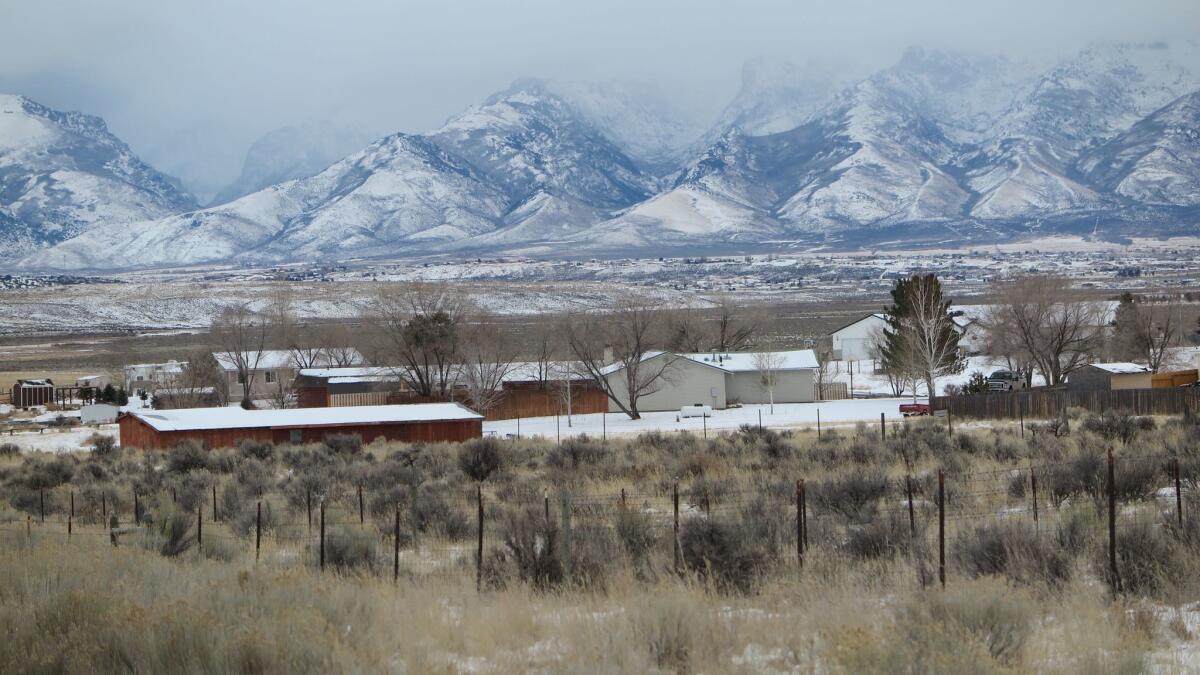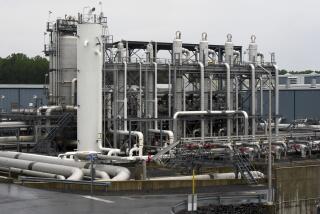Trump plan to expand oil and gas leasing in West draws, for the most part, a big yawn from industry

During his years in the White House, President Obama erected barriers to oil and gas development on the West’s public lands. President Trump, mindful of the energy industry’s view that those rules were too restrictive, has set his sights on dismantling them.
Yet for all the president’s support, federal lease auctions have attracted far less excitement than anticipated from oil and gas producers, even in heavily drilled areas of Wyoming, North Dakota, Utah and Colorado. In other Western states, and in Alaska, producers greet most new auctions with yawns.
In March, Trump issued an executive order to unshackle the energy industry from “regulatory burdens” and dispatched Interior Secretary Ryan Zinke to accelerate and expand the scope of federal oil and gas lease auctions. It was a major part of the president’s plan to re-establish “American energy dominance.”
Overall, the administration has insisted that its efforts are successful: The Interior Department reported that auctions of federal drilling leases earned $316.2 million in revenue in 2017, about 61% higher than the $196.7 million that the government made from leasing in 2016.
Here is where the Trump administration wants to expand offshore oil and gas drilling »
In a handful of oil-rich areas of the West, producers are eager to lease. A February lease auction attracted $129 million in sales for 183,155 acres, mostly in Wyoming, an average of $705 an acre. A September lease sale in New Mexico’s Permian Basin attracted nearly $131 million in sales from 61 parcels covering 15,331 acres, an average of about $8,545 an acre.
“It’s better to produce energy here under reasonable regulations than to watch it be produced overseas with no regulation,” Zinke told reporters last summer.
But those leases are the exception.
In early December, the Bureau of Land Management, a unit of the Interior Department, held a lease auction for 900 parcels and 10.25 million acres of the National Petroleum Reserve along Alaska’s North Slope. Just seven parcels covering nearly 80,000 acres received bids. The highest bid was $14.99 an acre, indicating meager interest.
Another December auction in Wyoming offered 45 parcels for lease. Four parcels covering 2,978 acres attracted strong bids ranging from $301 to $3,271 an acre. But 19 parcels covering almost 37,000 acres were bid at just $2 an acre, the minimum amount accepted by the government. Four other parcels covering over 4,000 acres attracted no bids at all.
The BLM district in Ely, Nev., south of Elko, also offered 208 parcels for lease in December that spanned nearly 389,000 acres of public land. Bids were received on just 17 parcels spanning 33,483 acres. The producers bid the minimum $2 an acre, which typically means the buyer is a speculator hoping to resell the lease, or use it as a financial asset for bank loans without any intent to drill.
“The administration is trying to remove some obstacles to leasing on public lands, and that is a positive sign,” said Kathleen Sgamma, president of the Western Energy Alliance, a Denver-based trade association. “But public lands production still has a higher break-even price. Producers take that into account, which is why some of the lease sales are not attracting interest.”
Environmental groups are alarmed by how close the administration’s leasing program is to sensitive areas across the West. Auctions scheduled for March will seek bids for sensitive public lands in Montana near Yellowstone National Park, and in Utah close to Canyonlands National Park. But in those regions, as here in northeast Nevada, it is far from clear how much interest an auction will generate.
Why? In Nevada’s Ruby Mountains, where a lease auction is proposed, geological surveys “show there is low to no potential for oil,” said Jenna Padilla, the geologist for the Humboldt-Toiyabe Ruby Mountains ranger district.

Roughly 32 million acres of federal land are under lease across the West and Alaska, according to the Interior Department. Over 100,000 wells have been drilled, producing 166 million barrels of oil annually (less than 5% of U.S. production) and 3.2 trillion cubic feet of natural gas — about 11% of U.S. annual production, according to the Energy Information Administration, an Energy Department statistics unit.
The Obama administration declared a moratorium on offshore leasing in the Gulf of Mexico following the Deepwater Horizon explosion and oil spill in 2010, and it trimmed federal onshore drilling and lease auctions. The number of new wells drilled on public lands, according to government figures, plummeted from 5,004 in 2008, the year before Obama took office, to 847 in fiscal year 2016.
Trump campaigned on a promise to discard regulatory impediments and unleash the nation’s fossil fuel potential. With the help of cutbacks by Saudi Arabia producers, oil prices have climbed in the last year to $60 a barrel. American production, which has followed the rising price, reached 298.7 million barrels in October, most of it on private land, and more than any month since May 1971, according to the energy information unit.
But America’s demand for oil, which reached a 2005 peak of 20.8 million barrels daily, has fallen by more than 1 million barrels a day.
The faltering demand, along with much higher costs for exploring questionable reserves, and drilling and fracking very expensive wells that are often 10,000 feet beneath the surface, has made oil exploration riskier than ever.
For that reason, the administration’s work to boost onshore production from public lands is not at all assured. There may be no more apt region to illustrate the point than on the high sagebrush desert and in the magnificent 11,000-foot Ruby Mountains close to Elko, a northeast Nevada city of 20,000, midway between Reno and Salt Lake City.
Outside of Elko, the U.S. Forest Service is preparing an environmental assessment for a 54,000-acre auction, the first that may ever be held on the 6.3 million-acre Humboldt-Toiyabe, the largest national forest outside Alaska. The auction encompasses much of the Ruby Mountains, which are a unit of the national forest.
Since Elko’s start in 1868 as a stop on the Central Pacific Railroad, its founders and their heirs established a durable equilibrium between development and conservation of Elko County’s land, mineral, and water resources.
Even as cattle ranches spread across the grasslands in the eastern part of the county in the early part of the 20th century, landowners and government officers agreed to establish the nearly 38,000-acre Ruby Lake National Wildlife Refuge in 1938. Several ranchers helped to found the anti-government Sagebrush Rebellion in the 1970s to resist federal oversight of public lands. But a decade later, Elko residents, including a number of ranchers, supported establishing the 90,000-acre Ruby Mountains Wilderness, which protects much of the range and its sensitive trout streams and game bird domain.
In Elko County’s 17,202 square miles, the fourth-largest county in the U.S., there is plenty of room for recreation, grazing, wilderness, and one of the largest gold mining sectors in the world. “We have a big country here,” said Rex Steninger, a rancher, former newspaper publisher and one of five Elko County commissioners.
In September, though, as part of the Trump administration’s campaign to open more public land to leasing, the U.S. Forest Service disrupted the development-conservation equilibrium when it announced the start of a public process to open the 54,000-acre area in and around the Ruby Mountains for oil leasing.
The notice attracted immediate attention. Nearly 8,000 comments were received by Humboldt-Toiyabe managers. All but three comments expressed opposition that generally focused on two primary points.

The first is the value the mountains hold as one of the West’s beautiful and accessible places to hike, fish, hunt, camp, and sustain wildlife. “I’d like future generations to see all of the things in this world that are beautiful, and recognize the natural diversity that we have,” said Pam Harrington, a resident of nearby Crescent Valley and Nevada field coordinator for Trout Unlimited, a national conservation group. “Let’s do what we can to keep that.”
The second point is that, simply stated, there isn’t much oil to be had in Nevada. Production statewide fell to 278,000 barrels last year from more than 4 million barrels in 1990, according to state figures. Not a single barrel of oil or cubic foot of natural gas has been produced on federal land in Nevada for at least 15 years, according to government figures.
Still, the BLM holds regular lease auctions that are largely ignored by the industry. In 2016, the BLM offered 39 parcels and 50,415 acres for lease in its Elko district. The auction did not attract a single bid.
In 2017, the BLM tried again and offered 381 parcels spanning 700,561 acres in three separate auctions. Producers made bids on 40 parcels and 75,045 acres, at prices ranging from $2 to $8 an acre. The BLM did not have a firm estimate of how much it costs the government to prepare an auction.
“We’re required to hold auctions by regulation,” said Chris Rose, the spokesman for the BLM Nevada State Office. “We have secretarial orders that tell us to keep doing what we’re doing, and to make sure we do it in a timely manner.”
ALSO
Analysis: Trump has big plans for offshore oil development. But will it ever happen?
More to Read
Start your day right
Sign up for Essential California for news, features and recommendations from the L.A. Times and beyond in your inbox six days a week.
You may occasionally receive promotional content from the Los Angeles Times.






